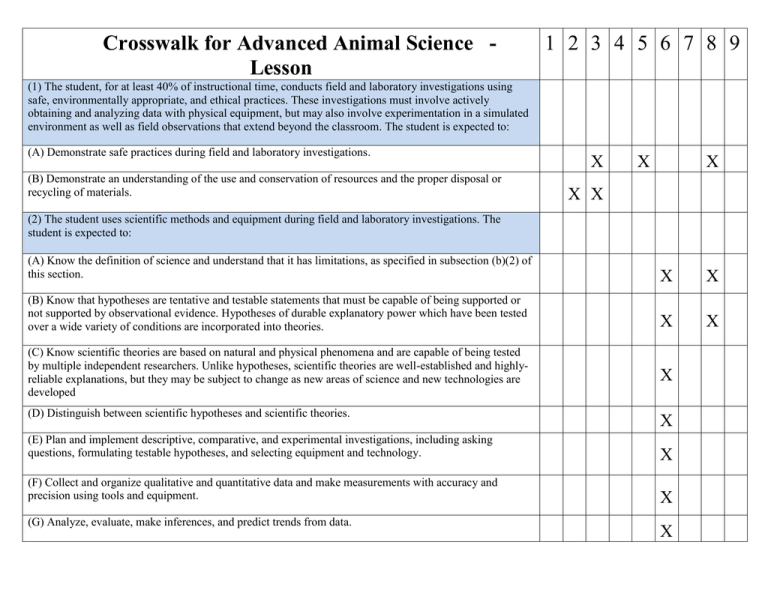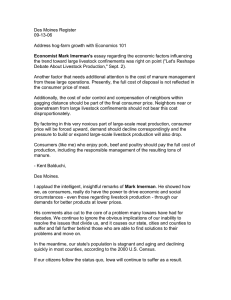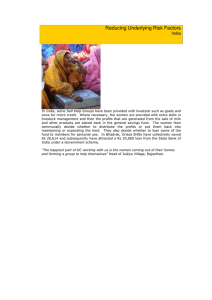Crosswalk for Advanced Animal Science - Lesson
advertisement

Crosswalk for Advanced Animal Science Lesson 1 2 3 4 5 6 7 8 9 (1) The student, for at least 40% of instructional time, conducts field and laboratory investigations using safe, environmentally appropriate, and ethical practices. These investigations must involve actively obtaining and analyzing data with physical equipment, but may also involve experimentation in a simulated environment as well as field observations that extend beyond the classroom. The student is expected to: (A) Demonstrate safe practices during field and laboratory investigations. (B) Demonstrate an understanding of the use and conservation of resources and the proper disposal or recycling of materials. X X X X X (2) The student uses scientific methods and equipment during field and laboratory investigations. The student is expected to: (A) Know the definition of science and understand that it has limitations, as specified in subsection (b)(2) of this section. X X (B) Know that hypotheses are tentative and testable statements that must be capable of being supported or not supported by observational evidence. Hypotheses of durable explanatory power which have been tested over a wide variety of conditions are incorporated into theories. X X (C) Know scientific theories are based on natural and physical phenomena and are capable of being tested by multiple independent researchers. Unlike hypotheses, scientific theories are well-established and highlyreliable explanations, but they may be subject to change as new areas of science and new technologies are developed (D) Distinguish between scientific hypotheses and scientific theories. X X (E) Plan and implement descriptive, comparative, and experimental investigations, including asking questions, formulating testable hypotheses, and selecting equipment and technology. X (F) Collect and organize qualitative and quantitative data and make measurements with accuracy and precision using tools and equipment. X (G) Analyze, evaluate, make inferences, and predict trends from data. X (H) Communicate valid conclusions supported by the data through methods such as lab reports, labeled drawings, graphic organizers, journals, summaries, oral reports, and technology-based reports. X (3) The student uses critical thinking, scientific reasoning, and problem solving to make informed decisions within and outside the classroom. The student is expected to: (A) In all fields of science, analyze, evaluate, and critique scientific explanations by using empirical evidence, logical reasoning, and experimental and observational testing, including examining all sides of scientific evidence of those scientific explanations, so as to encourage critical thinking by the student. X (B) Communicate and apply scientific information extracted from various sources such as current events, news reports, published journal articles, and marketing materials. X (C) Draw inferences based on data related to promotional materials for products and services. X (D) Evaluate the impact of scientific research on society and the environment. X (E) Evaluate models according to their limitations in representing biological objects or events. X (F) Research and describe the history of science and contributions of scientists. X (4) The student evaluates the employability characteristics of an employee. The student is expected to: (A) Identify career development and entrepreneurship opportunities in the field of animal systems. X X (B) Apply competencies related to resources, information, interpersonal skills, and systems of operation in animal systems. (C) Demonstrate knowledge of personal and occupational safety and health practices in the workplace. (D) Identify employers' expectations, including appropriate work habits, ethical conduct, legal responsibilities, and good citizenship skills. X X X X X X (5) The student demonstrates principles relating to the human, scientific, and technological dimensions of scientific animal agriculture and the resources necessary for producing domesticated animals. The student is expected to: (A) Evaluate market classes and grades of livestock. (B) Identify animal products and consumption patterns relative to human diet and health issues. (C) Describe the growth and development of livestock as a global commodity. X X X X X (6) The student applies the principles of reproduction and breeding to livestock improvement. The student is expected to: (A) Describe reproductive cycles and relate them to breeding systems. X (B) Explain the embryo transfer process and how it can impact the livestock industries. X (C) Recognize the significance of meiosis to sexual reproduction. (D) Evaluate animal behavior and its relationship to livestock management. X X X X (7) The student applies the principles of molecular genetics and heredity. The student is expected to: (A) Explain Mendel's laws of inheritance by predicting genotypes and phenotypes of offspring using the Punnett square. (B) Explain the inheritance of sex-linked characteristics and provide some examples found in animals. X X (C) Identify and compare the three parts of nucleic acids. (D) Explain the functions of nucleic acids. (E) Describe how heredity is used in the selection of livestock. (F) Explain how traits are passed from parent to offspring through genetic transfer and the implications of breeding practices. X X (8) The student examines and compares animal anatomy and physiology in livestock species. The student is expected to: (A) Identify and compare the external anatomy of a variety of livestock species. X (B) Compare the anatomy and physiology of the skeletal, muscular, reproductive, digestive, circulatory, genito-urinary, respiratory, nervous, and endocrine systems of animals. X (C) Describe interactions among various body systems such as circulatory, respiratory, and muscular systems. X (D) Identify and describe the functions of epithelial, connective, and muscular tissue and relate these to animal body systems. X (9) The student determines nutritional requirements of ruminant and non-ruminant animals. The student is expected to: (A) Describe the structures and functions of the digestive system of ruminant and non-ruminant animals, including poultry and cattle. X X (B) Identify and describe sources of nutrients and classes of feeds and relate to the ruminant and nonruminant animals. X (C) Identify and describe vitamins, minerals, and feed additives and how they relate to the nutritional requirements of ruminant and non-ruminant animals. X (D) Formulate rations based on different nutritional requirements. (E) Analyze feeding practices in relation to nutritional requirements of animals. (F) Analyze feed quality issues and determine their effect on animal health. X X X (10) The student evaluates animal diseases and parasites. The student is expected to: (A) Identify factors that influence the health of animals such as geographic location, age, genetic composition, and inherited diseases to a particular species. X X (B) Identify pathogens and describe the effects that diseases have on various body systems. (C) Explain the methods of prevention, control, and treatment for diseases. X X X (D) Describe the process of immunity and disease transmission. X (E) Explain how parasites are transmitted and the effect they have on the host. (F) Explain the methods of prevention, control, and treatment of internal and external parasites. X X X (G) Describe the life cycles of various parasites and relate them to animal health issues. X (H) Conduct parasite diagnostic tests. X (11) The student defines how an organism grows and how specialized cells, tissues, and organs develop. The student is expected to: (A) Compare cells from different parts of animals, including epithelia, muscles, and bones, to show specialization of structure and function. (B) Describe and explain cell differentiation in the development of organisms. (C) Sequence the levels of organization in animals and relate the parts to each other and to the whole. X X X (12) The student recognizes policies and issues in animal science. The student is expected to: (A) Discuss the impacts of biotechnology on the production of livestock such as cloning, artificial insemination, and freezing of semen and embryos. (B) Analyze the issues surrounding animal welfare and the humane treatment of livestock. X X (C) Apply principles of nutrition to maximize feed efficiency for livestock. (D) Design, conduct, and complete research to solve a self-identified problem in scientific animal agriculture. X X (13) The student discusses livestock harvesting operations. The student is expected to: (A) Map the stages of animal growth and development as it relates to market readiness. X (B) Describe the harvesting process. (C) Describe federal and state meat inspection standards such as safety, hygiene, and quality control. X (D) Identify retail and wholesale cuts of meat and meat by-products and correlate to major muscle groups. X (14) The student explores methods of marketing livestock. The student is expected to: (A) Compare various methods of marketing livestock. (B) Describe methods of marketing meat and meat products. X X (15) The student develops an advanced supervised agriculture experience program as it relates to agriculture, food, and natural resources. The student is expected to: (A) Plan, propose, conduct, and evaluate entrepreneurship; placement; exploratory; research, either experimental or analytical; improvement; supplementary; laboratory-based; or other identified, supervised agricultural experience as an experiential learning activity. (B) Apply proper record-keeping skills as they relate to a supervised experience. (C) Design and use a customized record-keeping system for the individual supervised experience. (D) Participate in youth leadership opportunities to create a well-rounded experience program in agriculture. (E) Produce a challenging approach for a local program of activities in agriculture. X X X X X X X X X X X X



